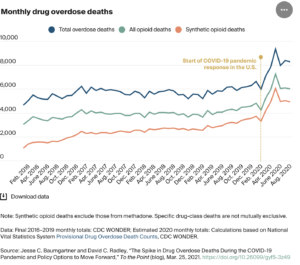
More than 100,000 Americans have died of drug overdoses in the 12-month period ending in April, marking the highest number ever, the Centers for Disease Control and Prevention (CDC) reported on Nov. 18.
That’s a 28.5 percent increase over the previous year, with the total number of drug overdose deaths doubling over the past five-year recorded period.
Fentanyl was listed as the leading drug to cause overdose fatalities, according to the report. The category of synthetic opioids, which includes fentanyl, involved 64 percent of all overdose deaths.
California led all states with a predicted 10,585 cases in April 2021. Florida ranked second with 7,892 cases.
President Joe Biden released a statement on Nov. 18 to address the rise in drug overdose cases among Americans.

Data: Final 2016–2019 monthly totals: CDC WONDER; Estimated 2020 monthly totals: Calculations based on National Vital Statistics System Provisional Drug Overdose Death Counts, CDC WONDER.
Source: Jesse C. Baumgartner and David C. Radley, “The Spike in Drug Overdose Deaths During the COVID-19 Pandemic and Policy Options to Move Forward,” To the Point (blog), Mar. 25, 2021. https://doi.org/10.26099/gyf5-3z49
“Today, new data reveal that our nation has reached a tragic milestone: More than 100,000 lives were lost to the overdose epidemic from April of last year to April of this year. As we continue to make strides to defeat the COVID-19 pandemic, we cannot overlook this epidemic of loss, which has touched families and communities across the country,” he said.
“As we grieve those we’ve lost and honor their memories, my administration is committed to doing everything in our power to address addiction and end the overdose epidemic.”
On Nov. 16, the director of the National Drug Control Policy also released a statement regarding recent participation to combat synthetic opioid trafficking from Mexico.
“Last week, Director of National Drug Control Policy Dr. Rahul Gupta participated in a Commission on Combating Synthetic Opioid Trafficking delegation to Mexico City and El Paso,” the statement said.
“He was joined by fellow Commission members Congressman David Trone (MD-06) and Drug Enforcement Administration (DEA) Chief of Operations Chris Evans.”
On Sept. 30, the Department of Justice announced seizures of historic amounts of deadly fentanyl-laced fake pills during a two-month period, including enough to kill “more than 700,000 Americans.”
“During the past eight weeks, DEA has targeted the criminal drug networks flooding the U.S. with deadly, fentanyl-laced fake pills,” DEA Administrator Anne Milgram said in the announcement.
“DEA remains steadfast in its commitment to reduce drug-related violence and overdose deaths by dismantling the violent, criminal drug distribution networks across the United States. The fentanyl-laced fake pills seized by DEA could potentially kill more than 700,000 Americans.
“I urge the American public today to talk to their loved ones about the threats and dangers of fake pills and the simple fact that one pill can kill.”
Since COVID-19 first started upending day-to-day life for Americans in March 2020, public health officials have been sounding the alarm about a potential surge in drug overdoses.
Overdose deaths rose during the second half of 2019, and experts feared the pandemic would produce conditions that would further increase overdoses and deaths: economic shock, social isolation and increased mental health distress, and disrupted access to addiction support and medications that require face-to-face visits.
Interim reports from government agencies and researchers have suggested these fears were being realized, with provisional data from the Centers for Disease Control and Prevention (CDC) now further supporting these claims.
Overdose Deaths Spiked After Start of the Pandemic, Driven by Synthetic Opioids Like Fentanyl
The CDC’s National Vital Statistics System (NVSS) provides monthly provisional data on predicted total drug overdose deaths during the preceding 12 months. The most recent data reflect September 2019 through August 2020. During that period, there were 88,295 predicted deaths, a record high that is almost 19,000 more deaths (27%) than the prior 12-month period.
Using these predicted data in combination with final data from 2019, we estimated monthly overdose deaths from January to August 2020. Our estimates show that total overdose deaths spiked to record levels in March 2020 after the pandemic hit. Monthly deaths grew by about 50 percent between February and May to more than 9,000; they were likely still around 8,000 in August. Prior to 2020, U.S. monthly overdose deaths had never risen above 6,300.
Opioid-related deaths drove these increases, specifically synthetic opioids such as fentanyl. Opioids accounted for around 75 percent of all overdose deaths during the early months of the pandemic; around 80 percent of those included synthetic opioids.
CDC recently published an interactive visualization tool with preliminary weekly estimates of overdose deaths. These data suggest that overdose deaths remained elevated well into the fall before declining toward the prepandemic baseline near the start of 2021. The final 2020 total in the United States could exceed 90,000 overdose deaths, compared to 70,630 in 2019. That would not only be the highest annual number on record, but the largest single-year percentage increase in the past 20 years.
Overdose Deaths Increased in Almost Every State During the First Eight Months of 2020
We also estimated how many overdose deaths each state experienced during the first eight months of 2020, compared to overdose deaths during the same period of 2019.
Overdose deaths increased in almost every state; 24 states and the District of Columbia had an estimated increase of at least 30 percent, and the overall U.S. total increased by 33 percent.
States like West Virginia and Kentucky have long been at the heart of the opioid epidemic, and that region is still reporting some of the largest proportional increases. Recent research has also highlighted the growing impact of fentanyl and overdose deaths within states farther West. Arizona, California, Colorado, Illinois, Texas, and Washington all experienced increases above 35 percent during the first eight months of 2020; Colorado recently reported record overdose deaths during full year 2020.
Looking Forward
President Biden campaigned on a platform to address the opioid crisis through a public health approach that includes expanding funding and resources, reforming the criminal justice system, increasing insurance coverage, and widening access to medication-assisted treatment (MAT) and mental health care. His administration has already faced early pressure to make it easier for providers to prescribe buprenorphine — a key component of MAT — during the pandemic.
One policy tool that can address multiple objectives is Medicaid expansion. Data continue to show the positive impact of expansion on coverage, MAT access, and mortality outcomes for substance-use patients.
By simply expanding Medicaid, nonexpansion states like Florida, Georgia, Tennessee, and South Carolina could access significant federal financing in their push to help an ever-growing number of people in need. These four states all experienced overdose death increases above 30 percent during the first eight months of 2020.
Utilizing Medicaid also decreases the reliance on annual discretionary funding to support siloed treatment programs, which has proven to be unsustainable in the fight to reduce drug overdoses. Policy experts recently argued for restructured financing of substance-use treatment through “mainstream public and private insurance programs” like Medicaid that allow states to reliably “pull” down funding as their needs increase.
But in the absence of further financing reform, federal discretionary funding has quickly increased to meet the growing crisis. The December 2020 funding package included $4.25 billion in mental health and substance-use emergency funding; the recently passed American Rescue Plan (ARP) will provide an additional $3.5 billion for block grants in these same areas. President Biden recently announced $2.5 billion to further support states.
Combined with ARP’s significant financial assistance for state and local governments, the targeted substance-use funding will likely be critical for struggling addiction-treatment providers and government agencies that account for a significant percentage of overall substance-use treatment funding. Many have had to contend with tighter budgets related to the pandemic’s economic impact.




